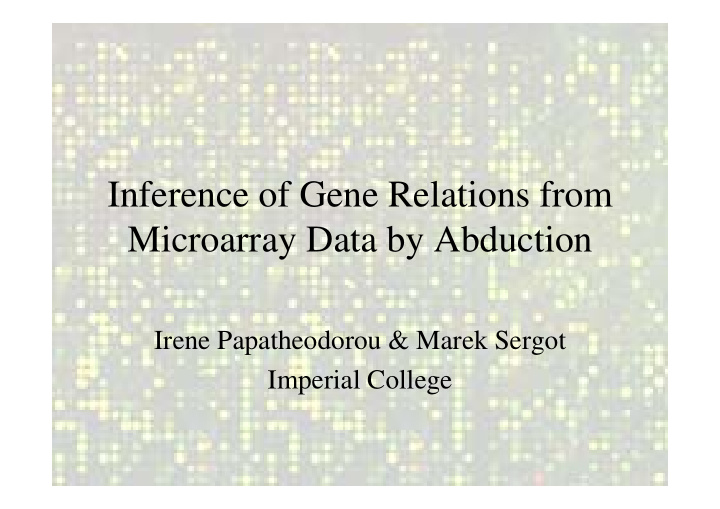



Inference of Gene Relations from Microarray Data by Abduction Irene Papatheodorou & Marek Sergot Imperial College
Outline • Gene Regulation & Microarrays • Abductive Reasoning • Model of Gene Interactions • Applications & Tests • Evaluation & Further Work
Gene Regulation Cell Response Gene Regulation: A B C External Stimulus Microarrays measure gene expression
Microarray Experiment Measures levels of gene expression A A B B Experiment: gene mutation/environmental stress
Expression Data to Gene Relations • Mycobacterium tuberculosis experiments from CMMI • Genomic Information-Background Knowledge • Gene Relations- inhibition/activation • Inference Method: Abduction
Deduction Organism A model of how observed gene X regulates gene Y genes work gene + gene U inhibits gene V (in general) expression : Infer the effect from rules
Abduction Organism A model of how observed gene X regulates gene Y genes work gene + gene U inhibits gene V (in general) expression : Inference from effect to cause
Abductive Inference • Theory represented by (P, A, IC) – P is a logic program – A is a set of abducible predicates – IC Integrity Constraints, logic rules • Abductive Procedure: Kakas-Mancarella (General Purpose) • Implementation: Alpha (R. Craven)
Gene Interaction Model • Rules & Integrity Constraints of Gene Interactions • Observables: increases_expression(Expt, Gene) reduces_expression(Expt, Gene) • Abducibles: induces(GeneA, GeneB) inhibits(GeneA, GeneB)
The Rules (Summary) Increased Knocked expression out in in expt E expt E INHIBITS* GENE 1 GENE 2 * Unless GENE 2 affected by another gene or GENE 2 affected by environmental stress 2 Parameters Recursive rules
The Model • Concept of gene interaction increases_expression(Expt, X) ← knocks_out(Expt, G), inhibits(G,X).
The Model: Exceptions • Top-level: Base case rule increases_expression(Expt, X) ← knocks_out(Expt, G), inhibits(G,X), not affected_by_other_gene(Expt, G, X), not affected_by_EnvFactor(Expt, X).
Rules of Gene Interaction • Top-level recursive rule: increases_ expression(Expt, X) ← knocks_out(Expt, G), candidate_gene(Expt,G1,G), reduces_expression(Expt,G1), inhibits(G1,X), not affected_by_EnvFactor(Expt, X). Parameter: candidate_gene/3
Rules of Gene Interaction affected_by_other_gene(Expt,G,X) ← increases_expression(Expt,Gx), Gx ≠ X, Gx ≠ G, related_genes(Gx, G), induces(Gx, X). Parameter: related_genes/2
The Parameters • “Related Genes” & “Intermediate Genes” • Focus search on different sets of genes • Transcription factors • Similar Function
Integrity Constraints • Self-consistency: False: induces(G1,G2), inhibits(G1,G2). • Consistency with prior knowledge: False: induces(a,G). False: induces(G1,X), induces(G2,X), same_operon(G1,G2). • Experimental Consistency: False: candidate_gene(E,G1,G2), mutates(E,G2), not affects(E,G1).
M.tuberculosis: 1 Observation • Observation: increases_expression(hspR, ‘Rv0350’) • Hypothesis: Hyp = [inhibits(‘Rv0353’, ‘Rv0350’)] – ‘Rv0353’ is mutated in hspR – ‘Rv0350’ is not affected by Environmental Factor – ‘Rv0350’ is not affected by other gene
M.tuberculosis: 2 Hypotheses • Observation: reduces_expression(sigH, ‘Rv2710’) • Hypotheses: Hyp = [induces(‘Rv3223c’, ‘Rv2710’)] Hyp = [induces(‘Rv3223c’, ‘Rv1221’), induces(‘Rv1221’, ‘Rv2710’)]
M.tuberculosis: Regulators
Evaluation • General Method for Microarray Analysis • Simple and Flexible Model • Enables comparison of experiments • Reduces Time of Analysis
Future Work Directions • Integrate output with pathway information • Investigate different methods of formulating the problem • Improve Performance of Abductive Interpreters
Summary • Gene Regulation & Microarrays • Visualising Experiments • Abductive Model for Gene Interactions • Applications • Future Work
Questions Irene Papatheodorou ivp@doc.ic.ac.uk
Recommend
More recommend